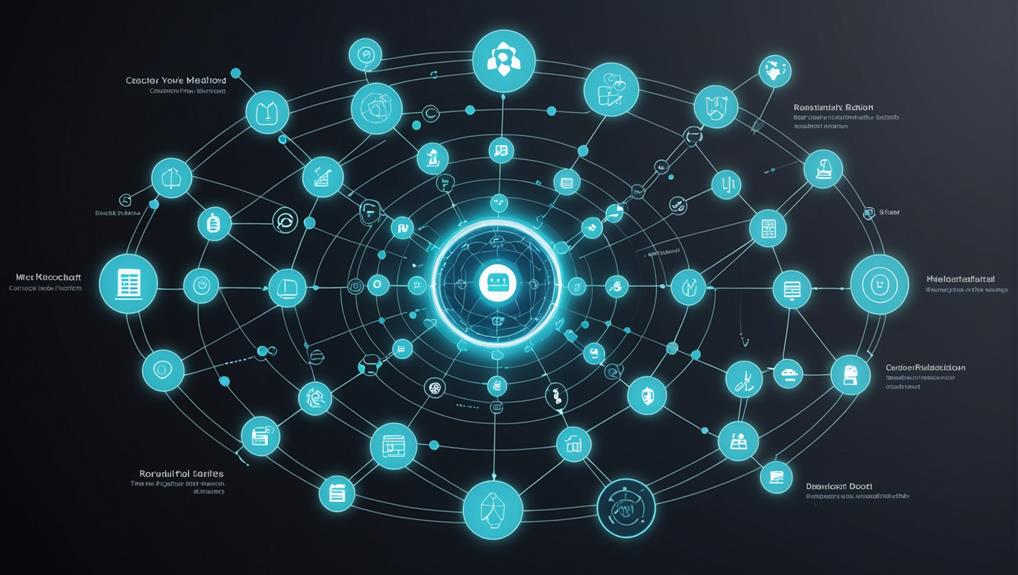Retrieval-Augmented Generation (RAG) is like giving a turbo boost to AI. Imagine an AI model that not only uses its own smarts but also pulls in the latest data from external sources to craft responses. It’s a two-step dance: first, the AI fetches info like a seasoned researcher, then it generates answers with the charm of a storyteller, all while staying relevant and up-to-date. Born in 2020, RAG tackles the quirks of traditional models, making AI outputs more accurate and contextually rich. Curious about how this powerhouse operates and its transformative potential? Keep exploring—you’ll be amazed!
Table of Contents
Key Takeaways
- RAG combines information retrieval with generative AI to produce accurate and contextually rich responses.
- It integrates external knowledge bases, enhancing the reliability and relevance of AI-generated content.
- Developed in 2020, RAG addresses hallucinations and ambiguities common in traditional generative models.
- Operates through retrieval and generation phases, ensuring answers are supported by updated information.
- Enables real-time updates and improved accuracy without needing to retrain the large language model.
Understanding RAG

Retrieval-Augmented Generation (RAG) transforms the landscape of generative AI by embedding a retrieval mechanism that taps into external knowledge bases to enhance the output of large language models (LLMs).
Imagine having a supercharged assistant that doesn’t just rely on its memory but also consults encyclopedias, databases, and the latest articles before giving you an answer. That’s RAG in summary.
At its core, retrieval-augmented generation is designed to fetch and blend external knowledge with the internal capabilities of LLMs, making the responses not only more accurate but also incredibly relevant.
How does it work? First, it uses information retrieval techniques to gather relevant data from a vast array of sources based on your query. Then, it integrates this freshly retrieved information with the LLM’s pre-existing knowledge to produce coherent and contextually rich responses.
This dynamic duo—retrieval and generation—ensures that the AI doesn’t just hallucinate answers but grounds them in verifiable facts, leading to accurate results.
Plus, because RAG doesn’t require retraining the LLM, it can be continuously updated with new information, making it a powerhouse for real-time applications like customer support and content creation.
History of RAG
The advent of Retrieval-Augmented Generation (RAG) in 2020 marked a pivotal moment in the evolution of generative AI. Conceived by Patrick Lewis, RAG emerged as a revolutionary framework designed to elevate the performance of large language models (LLMs) by incorporating external knowledge sources directly into their responses.
Despite Lewis’s later regret over the somewhat unfortunate acronym, the concept gained rapid traction due to its transformative potential.
RAG was introduced to tackle the persistent challenges of hallucinations and ambiguous answers that often plagued generative AI applications. By retrieving up-to-date information from diverse databases, RAG guarantees that responses are not only accurate but also relevant, thereby greatly enhancing user trust.
This innovative approach captivated major industry players such as AWS, IBM, and Google, who swiftly embraced RAG for its real-world applicability.
The framework’s ability to incorporate external knowledge sources brought a new level of credibility to generative AI, which traditional LLMs struggled to achieve.
Researchers and practitioners alike recognized that RAG’s capability to cite sources in its outputs was a game-changer, setting a new standard for reliability in AI-generated content.
As a result, RAG has become indispensable in applications where accuracy and trust are paramount.
How RAG Works

Building on the robust foundation laid by the history of Retrieval-Augmented Generation (RAG), understanding its operational mechanisms reveals why it has become such a transformative force in AI.
RAG operates through a two-step process: the retrieval phase and the generation phase. The retrieval phase kicks off by using embedding models to convert user queries into vectors. These vectors are like the language model’s way of understanding what you’re asking. With these vectors, RAG efficiently searches a vast vector database to find relevant information snippets.
Next comes the generation phase, where the magic really happens. The language model takes those retrieved snippets and combines them with its internal knowledge to synthesize coherent and contextually accurate responses.
This blend guarantees that the generated answers are not just pulled from thin air but are backed by updated, verifiable information.
RAG vs. Traditional Methods
Contrasting traditional AI methods with Retrieval-Augmented Generation (RAG) highlights a notable evolution in the capabilities of language models. Traditional methods, relying solely on static training data, often stumble when faced with the need for up-to-date, context-aware answers.
Imagine asking a traditional large language model (LLM) about the latest advancements in renewable energy, only to receive outdated information. Frustrating, right?
Enter RAG, the superhero of AI with its dynamic retrieval system, fetching real-time, relevant data. Unlike traditional models, RAG doesn’t get bogged down by old news. It taps into external knowledge sources, delivering precise and context-aware answers.
Think of it as having a librarian with instant access to the world’s most current databases, always ready to provide the latest scoop. This digital librarian not only delivers information at lightning speed but also curates it to suit specific needs, tailoring results to be both relevant and actionable. Whether you’re researching advancements in artificial intelligence or staying updated on future of work trends, this resource ensures you’re always a step ahead of the curve. In a world where information is power, this is the ultimate tool for staying informed and making data-driven decisions.
Moreover, RAG notably reduces the risk of inaccuracies, or as AI enthusiasts like to call them, “hallucinations.” Traditional methods can’t keep up with RAG’s ability to offer dynamic updates, enhancing both trust and credibility.
Plus, implementing RAG is a breeze—no need for extensive retraining cycles. Just a few tweaks, and voila! Your AI is smarter, faster, and more reliable.
Why settle for less when you can have cutting-edge technology at your fingertips?
Applications of RAG

Among the most transformative advancements in AI, Retrieval-Augmented Generation (RAG) stands out for its versatile applications across diverse industries. Imagine having a tool that not only fetches the latest information but also crafts intelligent responses—RAG does just that, making it a game-changer.
In customer support, RAG powers advanced chatbots. These bots aren’t just your run-of-the-mill automated replies; they generate personalized responses in real-time, boosting user satisfaction and slashing response times.
For content generation, RAG is a marketer’s best friend, automating the creation of blogs, articles, and product descriptions by synthesizing data from multiple sources. Say goodbye to writer’s block!
Market research gets a turbo boost with RAG, as it sifts through oceans of online data to pinpoint trends and insights, empowering businesses to stay competitive. Employees also benefit, gaining quick access to expert knowledge, which enhances productivity and decision-making.
In academic research, RAG is invaluable. It can summarize extensive documents and streamline literature reviews by delivering contextually relevant information from diverse sources. Imagine acing your next paper with half the effort!
With these applications, RAG not only redefines efficiency but also liberates users to focus on what truly matters.
Benefits of RAG
Retrieval-Augmented Generation (RAG) offers numerous benefits that greatly enhance the performance and reliability of AI systems. By leveraging advanced information retrieval techniques, RAG pulls relevant and up-to-date data from extensive knowledge bases. This dramatically improves the accuracy of responses, reducing the risk of the AI generating off-the-wall, hallucinated content—because nobody likes getting nonsense answers.
RAG’s knack for integrating multiple sources means it’s a pro at synthesizing information. This capability leads to richer, more contextually appropriate outputs, especially when dealing with complex queries. Imagine asking a customer support bot a tricky question and getting a spot-on, detailed answer. That’s RAG working its magic.
Another stellar benefit is the reduced need for extensive training data. RAG taps into existing knowledge bases, making it adaptable to various topics and domains without the need for exhaustive new datasets. Talk about efficiency!
Moreover, the architecture of RAG allows for real-time updates and quick error corrections. This means generative AI systems become more reliable and effective, maintaining their relevance in fast-paced environments. For those who crave freedom, this translates into AI systems that can keep up with real-world changes, providing timely and accurate support.
Challenges in RAG

While the advantages of Retrieval-Augmented Generation (RAG) are numerous, implementing this sophisticated AI technique does come with its set of challenges. For starters, RAG can be exceedingly *computationally intensive*. The dual processes of information retrieval and generation require hefty computational resources, which can be a strain on systems not built for such heavy lifting.
Accuracy of outputs is another critical issue. The quality of RAG’s responses hinges on the reliability of the underlying knowledge base. If the retrieval systems pull outdated or incorrect information, the output can be misleading or downright wrong. Ensuring *seamless communication* between retrieval mechanisms and generative models adds another layer of complexity, demanding meticulous integration.
Moreover, dealing with *inaccuracies in retrieved data* is no small feat. Establishing robust protocols to verify and correct these inaccuracies is essential to maintain the integrity of responses.
Yet, another hurdle is the limited understanding and awareness of RAG within many organizations. Without a clear grasp of its functionalities, stakeholders may hesitate to adopt this technology despite its potential.
Future of RAG
The evolution of Retrieval-Augmented Generation (RAG) heralds a transformative era for AI-driven applications, as ongoing innovations promise to elevate the precision and timeliness of automated responses.
Imagine an AI system that doesn’t just spit out pre-packaged answers but fetches the freshest, most relevant information from vast knowledge repositories. That’s the future of RAG.
Advancements in this field are set to make enterprise applications smarter and more responsive.
Picture customer support that not only answers your questions but understands your needs in real-time. With real-time data integration, RAG is improving the accuracy and relevance of AI responses, making it an invaluable asset across industries from healthcare to finance.
Moreover, ethical AI development is a top priority. Yes, we want our AI to be smart, but not at the expense of societal well-being. Responsible usage will guarantee RAG applications contribute positively while addressing global challenges.
Collaboration is the secret sauce here. Industry leaders and academic researchers are working hand-in-hand, integrating technologies like LangChain and advanced vector databases.
This synergy promises to streamline building and deploying AI solutions, making our tech dreams not just possible but practical.
Buckle up, because the future of RAG is blazing a trail toward a smarter, more responsive world.
Frequently Asked Questions
What Does RAG Stand for in Retrieval Augmented Generation?
RAG stands for Retrieval-Augmented Generation.
This innovative AI framework greatly enhances the output of language models by integrating accurate, up-to-date information from various external sources.
It operates by retrieving relevant data and then generating responses based on that information.
What Is the Retrieval Augmented Generation RAG Primarily Focused On?
Retrieval-Augmented Generation (RAG) is primarily focused on enhancing the performance of large language models by integrating up-to-date information from external sources.
This dual-step process involves retrieving relevant data based on user prompts and then generating accurate, coherent text responses.
What Is RAG in Simple Terms?
RAG is a cutting-edge AI technique that boosts a language model’s output by pulling in the latest info from various outside sources.
Imagine asking a question and getting a super-smart answer that combines the model’s built-in knowledge with fresh, accurate data.
This makes responses more relevant and up-to-date, perfect for applications like chatbots and customer support, where getting the right answer quickly is vital.
What Is the RAG Approach in Gen AI?
The RAG approach in generative AI combines the power of AI with real-time information retrieval.
Think of it as a turbo boost for AI models, enhancing their responses by fetching the latest data from various knowledge sources.
This dual-phase method guarantees that the AI not only generates coherent text but also grounds its answers in current, verifiable facts, reducing errors and making the output more reliable and relevant.
Conclusion
Retrieval-Augmented Generation (RAG) is revolutionizing artificial intelligence by integrating real-time data from diverse sources into language models, thereby enhancing the accuracy and relevance of responses. This innovative approach holds immense potential across various industries, offering dynamic adaptability and improved information retrieval. Despite some challenges, the future of RAG looks promising, with its ability to provide more precise and up-to-date information marking a significant leap forward in AI-driven solutions. RAG is poised to transform how information is accessed and utilized.






